Adding and Managing Comments Effectively
Comments enable people who collaborate on documents to ask questions, provide suggestions, insert notes, and generally annotate a document’s contents without inserting revisions or questions into the body of the document. When you work with a document that contains comments, you can display the comments in the Reviewing pane while viewing the document in any view, or in balloons if you’re working in Print Layout, Full Screen Reading, or Web Layout view. You can display the Reviewing pane in Print Layout, Web Layout, Outline, and Draft views. If you have the Reviewing pane open and switch to the Full Screen Reading view, the Reviewing pane closes and comments are shown in balloons.
When balloons display information, they appear next to your document’s contents in either the left or right margin. Figure 11–2 shows a sample document in Print Layout view, with comment balloons along the right and the Reviewing pane along the left.
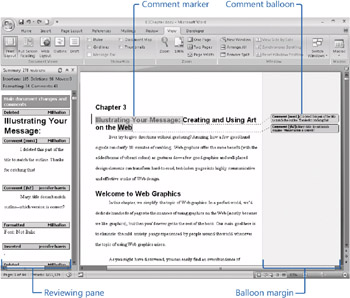
Figure 11–2: You can display color-coded comments in comment balloons or in the Reviewing pane. In both views, each comment includes the initials of the person who created the comment and a numeric identifier.
In addition to comment balloons, Word 2007 implements a number of visual cues when displaying comments. For example, notice in Figure 11–2 that in both the balloon and the Reviewing pane (in the shaded comment bar) the word Comment identifies the information as a comment. (You can also show insertions, deletions, and formatting changes in balloons and the Reviewing pane, as described in “Tracking Changes” on page 323.) Balloons and the comment bars in the Reviewing pane can be color-coded to associate them with particular users, and each comment bar in the Reviewing pane displays the user name of the person who inserted the comment. In addition, comments display the initials of the person who created the comment, and comments are automatically numbered throughout the document. The content associated with comments is shaded in the document to help link commented areas to corresponding comments. The shading of each instance of commented content matches the corresponding comment’s balloon color, which simplifies identifying who created which comments. The combination of user initials, comment numbering, and color-coded content shading makes identifying and referring to comments quite easy.
Configuring Reviewers’ User Names
Before you start inserting comments and tracked changes, you need to tell Word how to identify the marks you create. In other words, you need to configure your user name in Word. In fact, each person collaborating on the document must properly configure his or her user name to maximize the reviewing features. To set your user name information, you simply configure the Word Options settings. Word 2007 speeds up the process of accessing the settings by providing a link on the Review tab, as described here.
-
Click the Review tab, click the Track Changes arrow, and then click Change User Name. The Popular category in the Word Options dialog box is displayed. The user name settings are located in the Personalize Your Copy Of Microsoft Office section.
-
In the User Name box, type the name you want to use to identify your comments and then enter your initials in the Initials box, as shown in Figure 11–3.
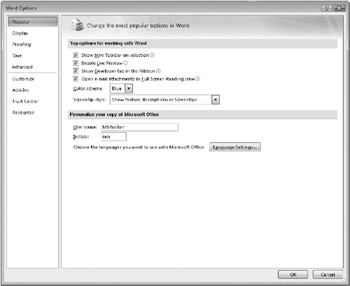
Figure 11–3: Word uses the user name and initials entered in the Word Options dialog box to identify comments in documents.
Keep in mind that the information you enter in the Word Options dialog box is used by all the 2007 Microsoft Office system programs. Any changes you make to these settings in Word will affect documents in other Microsoft Office system programs as well.
Fortunately, this is not as dire as it sounds. For example, if you’re temporarily using someone else’s computer to review a document, you can change the user name in the Word Options dialog box without affecting existing documents. Then, when you have finished working with the document on that computer, you can return to the Word Options dialog box to restore the original user information.
Configuring Colors Associated with Reviewers
By default, Word displays the comments and tracked changes for each reviewer of a document in a different color. If you prefer all comments and tracked changes to be displayed in a single color, you can change the default setting by clicking the Review tab, clicking the Track Changes arrow, and then clicking Change Tracking Options. The Track Changes Options dialog is shown in Figure 11–4.
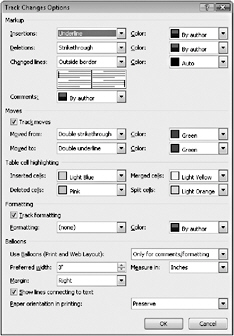
Figure 11–4: By default, comments, insertions, deletions, and formatting changes are displayed in a different color for each reviewer.
Using the Track Changes Options dialog box, you can specify a color for all comments, insertions, deletions, and formatting changes. By default, By Author is selected for Insertions, Deletions, and Comments, which means that Word automatically assigns a different color to each person who inserts comments or tracked changes. Keep in mind that this setting doesn’t always color-code each person’s changes with the same color every time. Instead, the By Author option simply guarantees that every person’s marks will appear in a distinct color-each person’s color will most likely change each time someone reopens the document. For more information about configuring other options in the Track Changes Options dialog box, see “Adjusting the Appearance of Tracked Changes” on page 323.
If you’re viewing a document in which comments for a number of reviewers have been color coded, you can quickly see which color is assigned to each reviewer. To do so, click Show Markup on the Review tab and then click Reviewers. You’ll see a list of the reviewers’ names accompanied by color-coded check boxes, as shown in Figure 11–5. (Of course, you can’t see the color-coding in this book, but you can get an idea of how the color-coding system works.) In addition to seeing reviewer color assignments, you can use the list of reviewers to specify whose comments and tracked changes are displayed in the current document by selecting or clearing the check boxes next to a reviewer’s name. When you clear a check box while in Print Layout, Full Screen Reading, or Web Layout view, that reviewer’s comment and tracked changes balloons are hidden, and text inserted by the reviewer appears as regular body text. To display a reviewer’s comments and changes again, just click the reviewer’s check box.
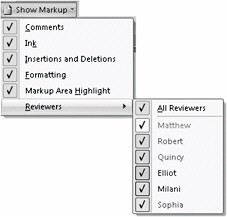
Figure 11–5: You can use the Reviewers menu to quickly see the colors currently assigned to reviewers and to control whose comments and changes are displayed in the current document.
| Inside Out-Optimizing a Document’s Readability When Some Reviewers’ Marks Are Hidden | When you turn off the display of a reviewer’s tracked changes, the text deleted by the reviewer appears as though it has been restored and text inserted by the reviewer appears as regular text. As you can imagine, this can result in some strange mixtures of restored and added text. If some text looks particularly confusing, display all reviewers’ marks before you enter additional (and possibly unnecessary) revisions. |
Allowing Reviewers to Use Only the Comments Feature
In addition to color-coding reviewers’ comments, you can control who can add comments to a document during the review phases of a project. To do this, use the Editing Restrictions setting in the Restrict Formatting And Editing task pane, shown in Figure 11–6. Using the Editing Restrictions feature, you can ensure that the only modifications reviewers can make to your document are to add comments.
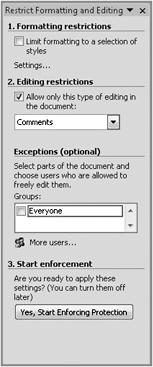
Figure 11–6: The Restrict Formatting And Editing task pane enables you to limit reviewers’ actions to only certain types of changes, such as inserting comments.
To set up editing restrictions, follow these steps.
-
Click Protect Document on the Review tab.
-
In the Restrict Formatting And Editing task pane, click the Allow Only This Type Of Editing In The Document check box and choose Comments in the list below the check box option.
-
Click More Users to specify any groups or users who are exceptions to the editing restriction.
-
Click Yes, Start Enforcing Protection. The Start Enforcing Protection dialog box opens.
-
If you want, type and confirm a password in the password boxes and click OK. If you specify a password, reviewers will have to enter the password before they can enter comments.
If you choose not to assign a password in step 5, reviewers will be restricted to inserting only comments by default. But if reviewers click the Stop Protection button in the Restrict Formatting And Editing task pane, they’ll be able to unlock the document and edit your document freely. In other words, this document protection plan is really more of a deterrent than a fail-safe protection, but many times a deterrent is all you really need.
Troubleshooting
I forgot the document protection password.
If you forget the password for a protected document, you can recover the document by circumventing the password protection. To do so, select the entire document (by pressing Ctrl+A), copy the document (by pressing Ctrl+C), and paste the document (by pressing Ctrl+V) into a new, blank document. This process creates a new document based on the existing document.
Fortunately, when you copy and paste a document that contains tracked changes and comments, the newly created document retains all the reviewers’ marks and color-coded settings. In contrast, when you copy and paste text that contains tracked changes in Word 2000 and earlier versions, the changes are accepted in the newly copied version of the text regardless of whether you’re ready to accept the changes.
Inserting Standard Comments
After you configure your user name information, specify how to color-code reviewers’ comments, and set any reviewer limitations, you are ready to insert comments into documents. Inserting a comment is a straightforward process. You can insert your comment at the insertion point, or you can select content that you want to associate with your comment. If you insert a comment at the insertion point, Word indicates the presence of your comment in the text by shading the nearest word and enclosing it in parentheses. (See Figure 11–2 for an example.) If you select content to be associated with a comment, Word marks the selected content in the same way, by shading the content and enclosing it in parentheses.
To insert a comment, follow these steps.
-
Position the insertion point where you want to insert a comment, or select the content you want to associate with your comment.
-
Click New Comment on the Review tab or press Ctrl+Alt+M.
If you’re working in Print Layout, Full Screen Reading, or Web Layout view, an empty balloon opens by default when you insert a comment. If you’re working in Outline or Draft view, the Reviewing pane opens.
Note By default, comment balloons are turned on in Print Layout, Full Screen Reading, and Web Layout views. If balloons are hidden, you can type comments in the Reviewing pane when you’re working in any view.
-
Type the comment you want to make in the comment balloon or the Reviewing pane and then click outside the balloon or Reviewing pane to complete the comment.
| Note | After you enter a comment in a balloon, you can press Esc to return the insertion point to the main body of the document. |
If you want to change a comment after you create it, you can do so by clicking inside the comment balloon or Reviewing pane and then editing the text just as you edit standard text. If a comment is long and its contents aren’t entirely displayed in a balloon, click the ellipses in the balloon to open the Reviewing pane. You can then modify the comment in the Reviewing pane. If the Reviewing pane isn’t open or the ellipses aren’t visible, click Reviewing Pane on the Review tab to open it. To close the Reviewing pane, click Reviewing Pane on the Review tab or press Alt+Shift+C.
| Inside Out-Editing Text in the Reviewing Pane | As in Word 2002 and Word 2003, in Word 2007 you can’t select text in the Reviewing pane and then press Backspace to delete it. Therefore, to delete text while working in the Reviewing pane, you need to either select the text and use the Delete key, or position your cursor at the text you want to delete and then use the Backspace or Delete key to delete the comment’s text one character at a time. You can press Ctrl+Backspace or Ctrl+Delete to delete entire words at a time. |
If you are using a Tablet PC, you can include voice comments and handwritten comments with documents. Basically, voice comments are sound objects added to comment balloons. Before you can add a voice comment, you need to add the Insert Voice button to the Quick Access Toolbar. See Chapter 2, “The 2007 Office System User Interface: What’s Changed, What’s the Same,” to learn how to customize the Quick Access Toolbar. To create ink comments, simply click the New Comment button on the Review tab and write your comment in the comment bubble.
Configuring Comment Balloon and Reviewing Pane Options
When you work with comment balloons (and track change balloons, as discussed in “Tracking Changes” on page 323), you can control a variety of balloon options. Specifically, you can format balloon and Reviewing pane label text (the text displayed on Reviewing pane bars above each comment or tracked change), specify when balloons will be displayed, adjust balloon width and placement, and specify whether lines should connect balloons to text.
Changing the Styles of Balloon and Reviewing Pane Text and Labels
You can modify the font styles of balloon and Reviewing pane text and labels (including the word Comment and user names) in the same manner you modify other styles in Word documents-by using the Styles task pane. To modify the Balloon Text style, which controls the balloon labels (such as Comment, Inserted, Deleted, and Formatted), and to change the Comment Text style (the text typed by reviewers), follow these steps.
-
Click the Styles Dialog Box Launcher on the Home tab (or press Ctrl+Alt+Shift+S) to open the Styles task pane.
-
In the Styles pane, click the Manage Styles button.
-
In the Manage Styles dialog box, select Alphabetical in the Sort Order list, select Balloon Text in the list of styles, and then click Modify.
-
In the Modify Style dialog box, select any options you want. Choose whether you want to make the changes to the current document only or add the formatting to the document’s template (either Normal.dotm or another attached template), and then click OK.
-
In the Manage Styles dialog box, select Comment Text and click Modify.
-
In the Modify Style dialog box, select any options you want. Choose whether you want to make the changes to the current document only or add the formatting to the document’s template, and then click OK twice to close both dialog boxes.
You can also modify comment text by selecting the text or label in an existing comment in the Reviewing pane or balloon, applying format settings, and then updating the style to match the selected text.
When you modify the Comment Text style, you change the appearance of the text only (not the labels) in the comment balloons and comment entries in the Reviewing pane (you do not modify the text displayed in tracked-change balloons or tracked-change Reviewing pane entries, as discussed in “Tracking Changes” on page 323.
Showing and Hiding Balloons
If you prefer to work with the Reviewing pane and not balloons, you can turn off balloons. Or if you prefer, you can use balloons only to show comments and formatting changes. To control balloon display in Print Layout, Full Screen Reading, and Web Layout views, you can configure the Use Balloons option in the Track Changes Options dialog box, or you can use the Balloons tool on the Review tab, as follows.
-
On the Review tab, click Balloons.
-
On the Balloon menu, specify a balloon setting by choosing one of the following options.
-
Show Revisions In Balloons Shows all changes in balloons (equivalent of Always in the Track Changes Options dialog box).
-
Show All Revisions Inline Turns off balloons (equivalent of Never in the Track Changes Options dialog box).
-
Show Only Comments And Formatting In Balloons Shows comments and formatting changes in balloons and shows inserted and deleted text inline (equivalent of Only For Comments/Formatting in the Track Changes Options dialog box).
-
Regardless of whether you hide or show balloons, comments will be displayed as ScreenTips when you position your mouse pointer over a comment marker.
| Note | You can specify whether the lines used to connect balloons to text are displayed or hidden by selecting or clearing the Show Lines Connecting To Text check box in the Track Changes Options dialog box. When you clear the Show Lines Connecting To Text check box, balloons are displayed in the margin without a connector line when they aren’t selected. When you select a comment, the comment is displayed with a solid line that connects the balloon to the comment marker in the text. |
Adjusting Balloon Size and Location for Online Viewing
If you are new to balloons, you might find that they take some getting used to, even if you’ve used comments and tracking tools in the Reviewing pane. To help you customize balloons to suit your working style, Microsoft provides a couple of options you can use to control the width and position of balloons when you choose to view them. In fact, you can control balloon width and location for online viewing as well as for printing purposes. This section addresses configuring the online presentation of balloons. For more information about configuring balloons for printing, see “Printing Comments” on page 321.
To set the balloon width and specify whether balloons are displayed in the right or left margin, you must configure the Track Changes Options dialog box as follows.
-
Click the Track Changes arrow on the Review tab and then click Change Tracking Options.
-
In the Track Changes Options dialog box, make sure that the Use Balloons (Print And Web Layout) list box is set to Always or to Only For Comments/Formatting.
-
Click the Measure In arrow and select whether you want to measure balloons in inches or as a percentage of the page. For more information about the Inches and Percent options, see “Sizing Balloons-Inches vs. Percentage” below.
-
In the Preferred Width box, enter a percentage or measurement (in inches) for the width of the balloons.
-
In the Margin box, choose the Left or Right option to specify on which side of the document window you want balloons to appear.
-
Click OK to apply the balloon settings.
Unfortunately, you can’t preview how your balloon settings will be displayed. The best approach when configuring balloons is to try a few settings and see which setting works best for you on your monitor.
| Inside Out-Sizing Balloons-Inches vs. Percentage | When you size balloons, Word configures them without compromising the document’s content area. This is accomplished by expanding the view of your document (not by reducing the document’s content area). To clarify, let’s look at the two sizing options: Inches and Percent. When you use the Inches setting, you provide a set size in which your balloons will appear in your document’s margin. For example, if you specify 2 inches, your page’s view will expand so that balloons will be displayed within an area that’s 2 inches wide, starting from the document’s margin. Similarly, if you size balloons using the Percent option, the balloons will be displayed as a percentage of the page’s size without compromising the document’s content area. For example, if you specify balloons to be 100 percent, the balloons will be sized equal to 100 percent of the page, and the width of your view will be expanded accordingly (doubled, in this case). You can easily see how balloons will be displayed relative to the current document by saving a setting (using Inches or Percent) and then viewing your document in Print Preview. |
Reviewing Comments
Let’s say your document has made its rounds, and now it’s up to you to review the comments reviewers have inserted into the document. You can review comments only, or you can review comments while you review tracked changes. In this section, we’ll look at the process of reviewing comments only. (For more information about reviewing tracked changes, see “Tracking Changes” on page 323.) To review only comments in any view, you must first hide tracked changes. Then, follow these steps.
-
On the Review tab, make sure that either Final Showing Markup or Original Showing Markup is selected in the Display For Review list.
-
Click Show Markup on the Review tab and make sure that only the Comments option is selected on the menu. To accomplish this, you’ll probably have to clear the check marks for Ink, Insertions And Deletions, and Formatting.
| Note | The Markup Area Highlight option on the Show Markup menu controls whether the balloon area appears shaded. By default, Markup Area Highlight is selected, and the balloon area appears light gray. |
After you complete these steps, comments and comment markers will be the only markup features visible in the current document. At this point, you can review the comments manually by scrolling through your document or the Reviewing pane, or you can jump from comment to comment by clicking the Next and Previous buttons in the Comments group on the Review tab. Depending on the current view, you can review comments as follows.
-
Draft view Comments are displayed in the Reviewing pane. The Reviewing pane will open automatically when you click Previous or Next in the Comments group on the Review tab.
-
Full Screen Reading view without balloons Comment markers are shown, but “2- the Reviewing pane is not displayed. You can view the comment by positioning your cursor over the comment marker and reading the ScreenTip.
-
Outline view Comments can be viewed as a ScreenTip or in the Reviewing pane. When you click Previous or Next in the Comments group on the Review tab, the Reviewing pane opens (if it isn’t open already), and the view changes to Draft view automatically.
-
Print Layout, Full Screen Reading, or Web Layout view with balloons The active comment balloon is indicated by a dark outline, darker shading, and solid connector line. Clicking Previous and Next moves from balloon to balloon. Note that in Full Screen Reading view, you can view comments but you cannot use the Previous and Next buttons; instead, press Ctrl+Down Arrow to proceed forward from balloon to balloon through a document or press Alt+Up Arrow or Alt+Down Arrow to move up or down among balloons on a single page. (The keyboard commands also work in Print Layout and Web Layout views.)
-
Print Layout or Web Layout view without balloons Comments can be viewed in the Reviewing pane. If the Reviewing pane isn’t open when you click Previous or Next, Word opens it automatically and highlights the previous or next comment.
| Note | You can also browse from comment to comment by using the Select Browse Object feature (press Ctrl+Alt+Home) or the Go To tab in the Find And Replace dialog box (press Ctrl+G). On the Go To tab, you can select Comment in the Go To What list and then choose to view all reviewers’ comments or a selected reviewer’s comments by selecting Any Reviewer or a specific name in the Enter Reviewer’s Name list. |
When you view comments in balloons, you might notice that some comments have an ellipsis in the lower-right corner. This symbol indicates that the entire comment text doesn’t fit in the balloon. To view the remainder of the comment, click the ellipsis to open the Reviewing pane, which will contain the entire contents of the comment.
Naturally, as you read through comments, you might want to respond to them. You can do so in the following ways.
-
Type directly in a comment, in which case your response won’t be color-coded according to your user name.
-
Click in the comment you want to respond to and then click New Comment on the Review tab or press Ctrl+Alt+M. A new comment balloon is inserted directly below the comment you’re responding to, or a blank entry opens in the Reviewing pane with the format Comment[initials##R##] in the header. The first number is the number of the comment, and the R## indicates that the comment is a response to the comment number indicated. To add your response, simply enter your comment.
| Note | To quickly see when a comment was inserted and who created it, you can hover the mouse pointer over the comment balloon. When you do this, a ScreenTip displays the comment’s creation date and time as well as the user name of the person who created the comment. If you’re working in the Reviewing pane, each Reviewing pane bar displays the user name and insertion date and time automatically. |
Deleting Comments
Generally, comments serve a temporary purpose-reviewers insert comments, someone addresses the comments, and then the comments are removed before the document’s final publication (either online or in print). If you work with comments, you need to know how to delete them so that you won’t unintentionally include them in your final publication. As you might expect, you can delete comments in several ways. Namely, you can delete a single comment, delete comments from a specific reviewer (or reviewers), or delete all comments, using the following techniques.
-
Delete a single comment. Right-click a comment balloon and then click Delete Comment on the shortcut menu. Or select a comment balloon and then click Delete in the Comments group on the Review tab.
-
Delete comments from a specific reviewer. First clear the check boxes for all reviewers by clicking Show Markup on the Review tab and choosing Reviewers, All Reviewers. Now display only the comments you want to delete by clicking Show Markup, clicking Reviewers, and then selecting the check box next to the reviewer’s name whose comments you want to delete. (You can repeat this process to select additional reviewers as well.) To delete the displayed comments, click the Delete arrow in the Comments group on the Review tab and then click Delete All Comments Shown.
-
Delete all comments in the document. Make sure that all reviewers’ comments are displayed. (This is the default setting, but if all reviewers’ comments aren’t displayed, click Show Markup on the Review tab and choose Reviewers, All Reviewers.) Click the Delete arrow in the Comments group on the Review tab and then click Delete All Comments In Document.
You can remove all comments and revisions by using the Document Inspector. To do so, click the Microsoft Office Button, Prepare, Inspect Document. Be sure that the Comments, Revisions, Versions, And Annotations check box is selected. Then click Inspect. If the Document Inspector finds any leftover comments or revisions, you can click Remove All to accept all revision marks and delete all comments.
Keep in mind that when you use the Remove All option in the Document Inspector to delete all revisions and comments, you cannot use the Undo command to retrieve the revisions and comments. If you suddenly realize you do not want to remove the revisions and comments after you click Remove All, your only recourse is to close the document without saving changes.
For more information about using the Document Inspector, see Chapter 3, “Managing Security and Privacy in the 2007 Office System.”
Keep in mind that when you delete all comments at once by choosing the Delete All Comments In Document option, you delete all comments in the document, regardless of whether they are displayed on the screen.
| Note | You can also delete comments one at a time in the Reviewing pane. To do so, right-click a comment in the Reviewing pane and choose Delete Comment on the shortcut menu, or click in a comment and click Delete on the Review tab. |
Printing Comments
As previously mentioned, you can control how comments are displayed on the screen as well as in print. “Configuring Comment Balloon and Reviewing Pane Options” on page 334 addresses how to control the display of comments in balloons and in the Reviewing pane. This section discusses the ways you can print comments. When you print a document containing comments (and tracked changes, for that matter), you can configure print settings in two areas: the Track Changes Options dialog box and the Print dialog box. Let’s look first at the Track Changes Options dialog box.
In the Balloons section of the Track Changes Options dialog box (click the Track Changes arrow on the Review tab and then click Change Tracking Options to open the dialog box), you can specify how Word should adjust paper orientation to accommodate balloons. You can select any of the following settings in the Paper Orientation list.
-
Auto Specifies that Word can determine the best orientation for your document, based on your margin settings and balloon width settings.
-
Preserve Prints the document with the orientation specified in the Page Setup dialog box. This is the default setting.
-
Force Landscape Prints balloons and the document in landscape format to allow the most room for the display of balloons.
After you choose how you want Word to handle page orientation issues when you print documents with comment balloons, you’re ready to configure the Print dialog box.
In the Print dialog box (click the Microsoft Office Button, Print), you can specify whether to print the document showing markup (the default setting when comments and tracked changes are displayed), or you can opt to print just a list of the markup changes made in a document. Most likely, if you want to print a document’s changes, you’ll want to print the document showing changes instead of printing a list of changes. When you print a list of changes, the list can become long and confusing.
The easiest way to print a document with its comments is to print the document with comment balloons in the margin and hide the other types of margin balloons (including balloons that show insertions, deletions, and formatting changes). To efficiently print comments in a document, follow these steps.
-
Display your document in Print Layout view.
-
On the Review tab, click the Balloons button and choose Show Only Comments And Formatting In Balloons.
-
If you want, click Show Markup and clear the check mark for Formatting so that only comment balloons are shown. You can also hide inline revision marks if you want.
-
Click the Microsoft Office Button, Print or press Ctrl+P to open the Print dialog box.
-
In the Print dialog box, make sure that the Print What box shows Document Showing Markup, and then click OK.
The document will be printed with comment balloons in the margin. Word will reduce the view of the page to accommodate printing balloons in the margins. This doesn’t affect your document’s layout parameters-it’s just a temporary modification for printing purposes when you’re printing balloons along with a document.
| Note | When you print a document with markup, the Markup Area Highlight shading (the light gray shading behind balloons onscreen) is not printed. |
Saving a Document with Comments as a Web Page
You can save a document that contains comments and other marked-up text as a Web page. When you do this, Word retains the comments and tracked changes in the text. To save a reviewed document as a Web page, click the Microsoft Office Button, Save As, Other Formats. In the Save As dialog box, select Web Page in the Save As Type box and then click Save.
Keep in mind that the online display of comments and tracked changes in your document depends on your browser. In Microsoft Internet Explorer 4 and later, comments appear as dynamic ScreenTips, as shown in Figure 11–7. Also, revised text appears in a color other than black with underlining and strikethrough formatting, similar to how you see markup changes in Word when a single color is selected to show markup. In browsers earlier than Internet Explorer 4, and in Netscape Navigator 4 and later, comments appear as footnotes beneath the main Web page instead of as dynamic ScreenTips.
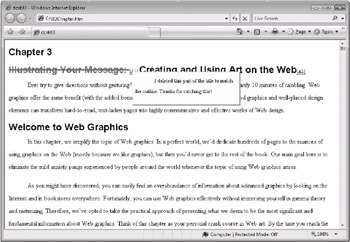
Figure 11–7: When you save a marked-up document as a Web page, Internet Explorer users can view comments in the form of dynamic ScreenTips by positioning the mouse pointer over a comment link.
EAN: 2147483647
Pages: 299